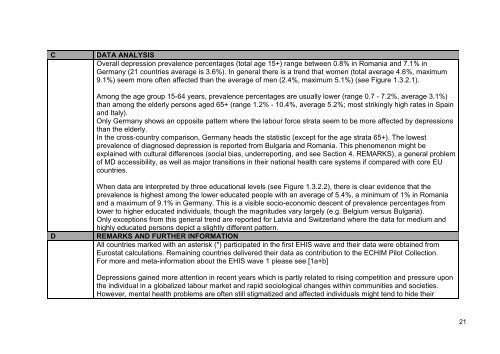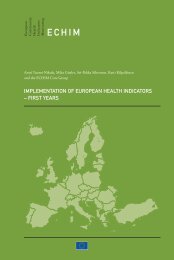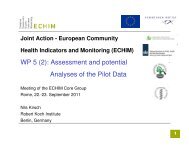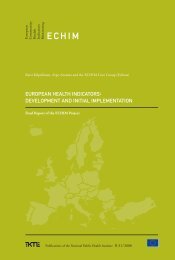Final Report Part III ECHIM Pilot Data Collection Analyses and Dissemination
Part III: ECHIM Pilot Data Collection, Analyses and Dissemination
Part III: ECHIM Pilot Data Collection, Analyses and Dissemination
- No tags were found...
Create successful ePaper yourself
Turn your PDF publications into a flip-book with our unique Google optimized e-Paper software.
C<br />
DATA ANALYSIS<br />
Overall depression prevalence percentages (total age 15+) range between 0.8% in Romania <strong>and</strong> 7.1% in<br />
Germany (21 countries average is 3.6%). In general there is a trend that women (total average 4.6%, maximum<br />
9.1%) seem more often affected than the average of men (2.4%, maximum 5.1%) (see Figure 1.3.2.1).<br />
Among the age group 15-64 years, prevalence percentages are usually lower (range 0.7 - 7.2%, average 3.1%)<br />
than among the elderly persons aged 65+ (range 1.2% - 10.4%, average 5.2%; most strikingly high rates in Spain<br />
<strong>and</strong> Italy).<br />
Only Germany shows an opposite pattern where the labour force strata seem to be more affected by depressions<br />
than the elderly.<br />
In the cross-country comparison, Germany heads the statistic (except for the age strata 65+). The lowest<br />
prevalence of diagnosed depression is reported from Bulgaria <strong>and</strong> Romania. This phenomenon might be<br />
explained with cultural differences (social bias, underreporting, <strong>and</strong> see Section 4. REMARKS), a general problem<br />
of MD accessibility, as well as major transitions in their national health care systems if compared with core EU<br />
countries.<br />
D<br />
When data are interpreted by three educational levels (see Figure 1.3.2.2), there is clear evidence that the<br />
prevalence is highest among the lower educated people with an average of 5.4%, a minimum of 1% in Romania<br />
<strong>and</strong> a maximum of 9.1% in Germany. This is a visible socio-economic descent of prevalence percentages from<br />
lower to higher educated individuals, though the magnitudes vary largely (e.g. Belgium versus Bulgaria).<br />
Only exceptions from this general trend are reported for Latvia <strong>and</strong> Switzerl<strong>and</strong> where the data for medium <strong>and</strong><br />
highly educated persons depict a slightly different pattern.<br />
REMARKS AND FURTHER INFORMATION<br />
All countries marked with an asterisk (*) participated in the first EHIS wave <strong>and</strong> their data were obtained from<br />
Eurostat calculations. Remaining countries delivered their data as contribution to the <strong>ECHIM</strong> <strong>Pilot</strong> <strong>Collection</strong>.<br />
For more <strong>and</strong> meta-information about the EHIS wave 1 please see [1a+b]<br />
Depressions gained more attention in recent years which is partly related to rising competition <strong>and</strong> pressure upon<br />
the individual in a globalized labour market <strong>and</strong> rapid sociological changes within communities <strong>and</strong> societies.<br />
However, mental health problems are often still stigmatized <strong>and</strong> affected individuals might tend to hide their<br />
21










